The iPad Air Review
by Anand Lal Shimpi on October 29, 2013 9:00 PM ESTGPU Performance
Since the iPad Air uses the same A7 silicon as the iPhone 5s, it also uses the same on-die GPU as the 5s: IMG’s PowerVR G6430. This is a 4-cluster configuration of IMG’s latest graphics hardware, running at some relatively high frequency. I already went into some detail on the G6430 in our 5s review so I won’t rehash that here, but we’re basically looking at a shift to a more efficient scalar architecture.
I still don’t have confirmations of clock speeds, but I believe we’re looking at a max GPU clock of around 450MHz. As you’ll see from the results below, there’s a small difference in performance between the iPad Air and iPhone 5s in terms of peak GPU performance - implying very similar clocks. The difference is the iPad Air should be able to sustain its max frequency longer than the iPhone 5s can.
| Mobile SoC GPU Comparison | ||||||||||||
| PowerVR SGX 554MP4 | PowerVR G6430 | PowerVR G6430 | ||||||||||
| Used In | iPad 4 | iPhone 5s | iPad Air | |||||||||
| SIMD Name | USSE2 | USC | USC | |||||||||
| # of SIMDs | 32 | 4 | 4 | |||||||||
| MADs per SIMD | 4 | 32 | 32 | |||||||||
| Total MADs | 128 | 128 | 128 | |||||||||
| GFLOPS @ 300MHz | 76.8 GFLOPS | 76.8 GFLOPS | 76.8 GFLOPS | |||||||||
| GFLOPS as Shipping | 68.1 GFLOPS (?) | 115.2 GFLOPS | 115.2 GFLOPS | |||||||||
Since we’re talking about an A7 here and not an X-series SoC, there’s still only a 64-bit wide memory interface. As memory bandwidth is a key enabler of GPU performance I was curious to see how GPU performance compared to the outgoing iPad 4 with its much wider memory interface. Do keep in mind that the A7 does include a large system cache on-die, which can help improve effective memory bandwidth.
GFXBench 2.7
We'll start our GPU performance analysis with a look at low level results using GFXBench/GLBenchmark 2.7. The low level tests, particularly the offscreen ones, should give us some idea as to whether or not there's any increase in GPU frequency for the iPad Air vs. iPhone 5s implementations of A7.
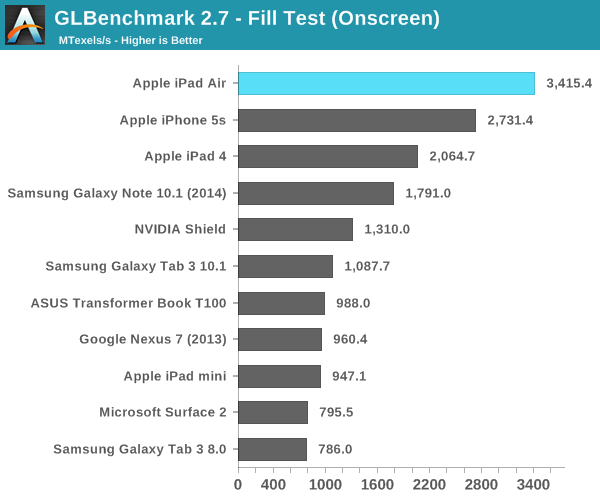
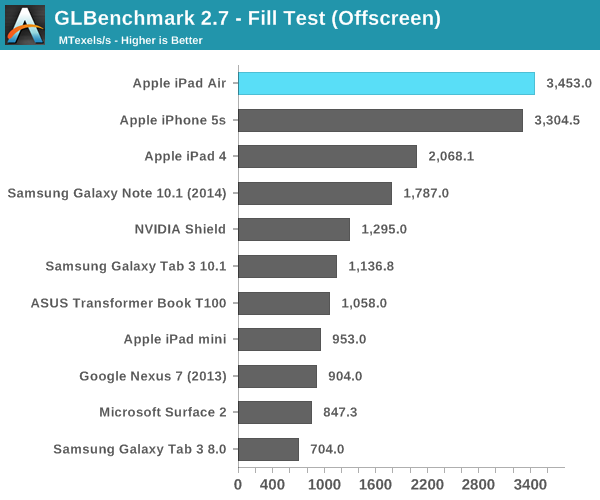
Looking at the fill rate results, there's a 4.5% increase in performance compared to the iPhone 5s. That could be the magnitude of clock increase that we're seeing between A7s. Apple could very well be relying on more thermal headroom in the iPad Air to provide any real world GPU performance advantages over the iPhone 5s.
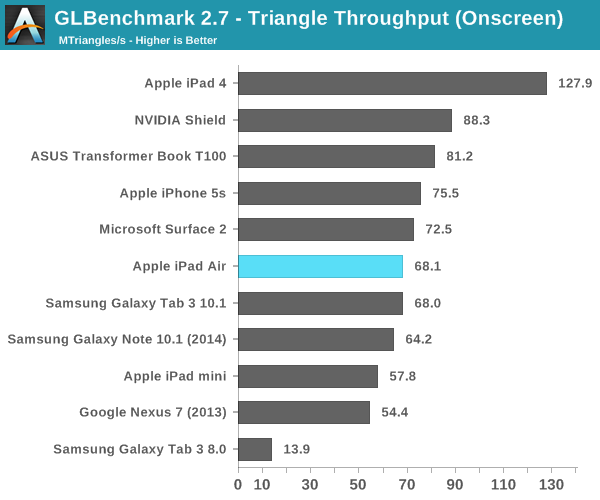

We see an even smaller gap between the Air and 5s in the triangle throughput tests (2.9%). There doesn't seem to be any substantial difference in GPU frequency between A7 implementations here. The regression in triangle rate performance compared to the iPad 4 is explained by differences in how Series 6 and Series 5XT GPUs scale in width. Whereas 5XT replicated nearly the entire GPU for "multi-core" versions, multi-cluster versions of Rogue only replicate at the shader array. The result? We don't see the same sort of peak triangle setup scaling we did back on multi-core 5XT parts. I'm not sure I'm particularly happy with the magnitude of the regression here, but I haven't seen any real world cases where it matters yet.
Next up are the game simulation tests. We'll start with the more strenuous of the two: T-Rex HD.
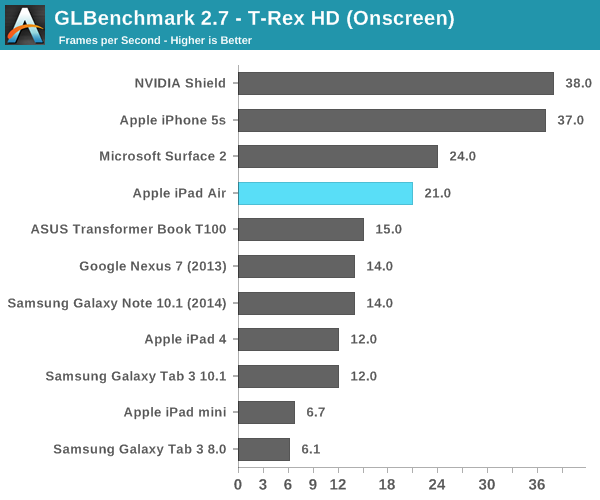
Here we get closer to Apple's claims of a 2x increase in performance. The iPad Air delivers 75% more performance than the iPad 4 in this test. Once again the iPhone 5s pulls ahead but that's because the onscreen tests render at display resolution, which is lower on the 5s.
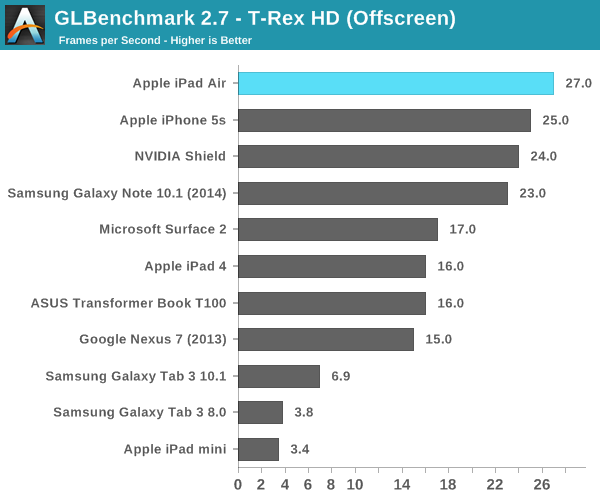
Offscreen performance sees similar scaling: ~69% better performance compared to the iPad 4.
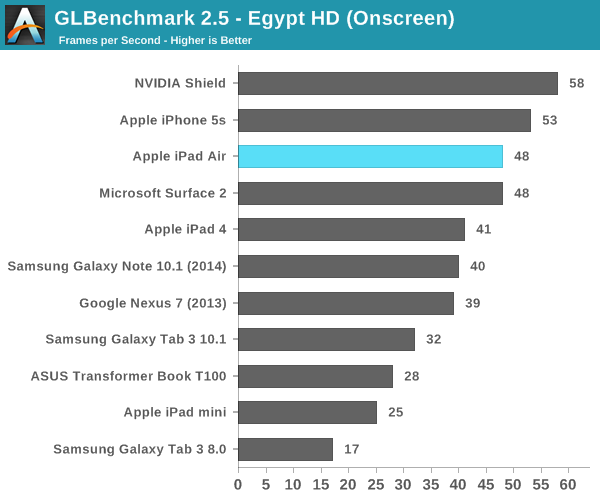
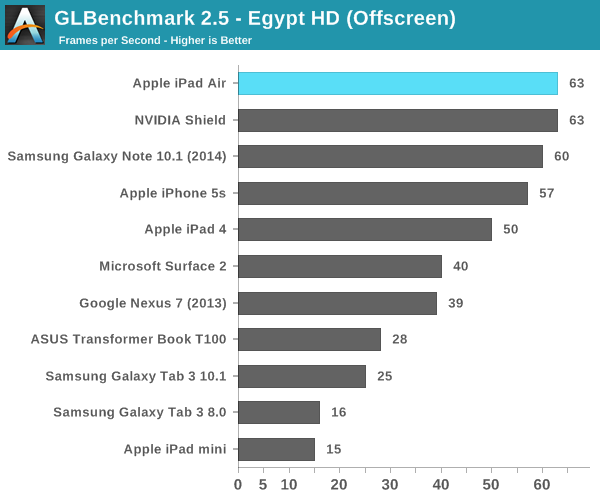
3DMark
We're once again running 3DMark's newest Unlimited mode which does its best to run independently of v-sync and at a standard resolution across all devices. I've also included 3DMark Extreme results below that feature a few more comparison points.
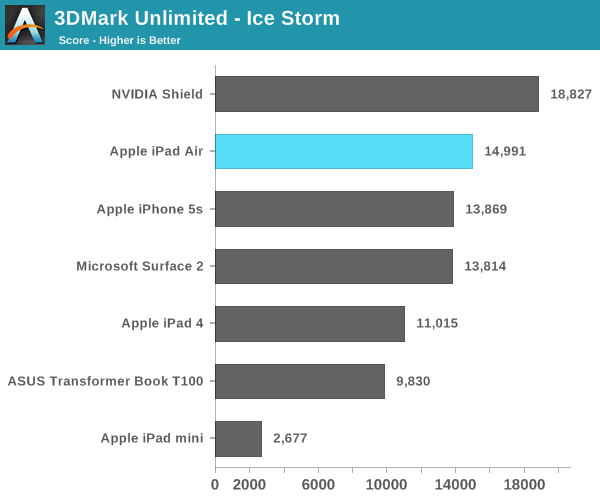
The overall Ice Storm scores show a 36% improvement in performance over the iPad 4 and an 8% increase compared to the iPhone 5s. Given the CPU frequency advantage of the A7 in the Air vs. the iPhone 5s, I'm guessing that's why we're seeing the performance gap we are here.
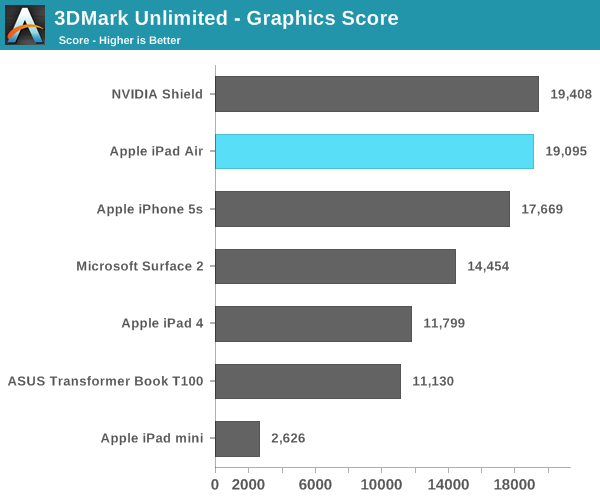
If we focus exclusively on the GPU tests (which themselves are still CPU bound), the iPad Air's performance advantage over the iPad 4 grows to over 60%.
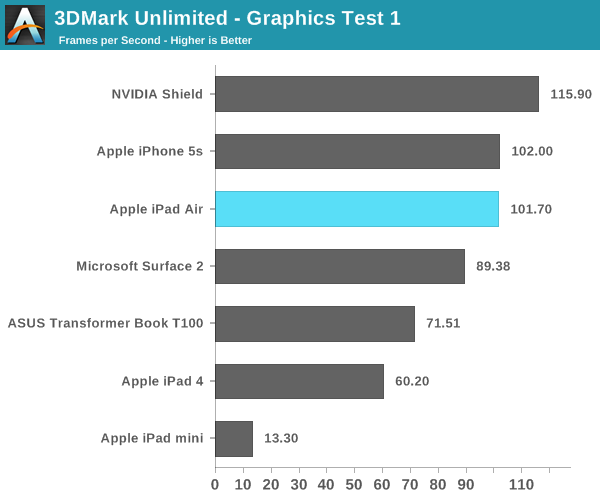
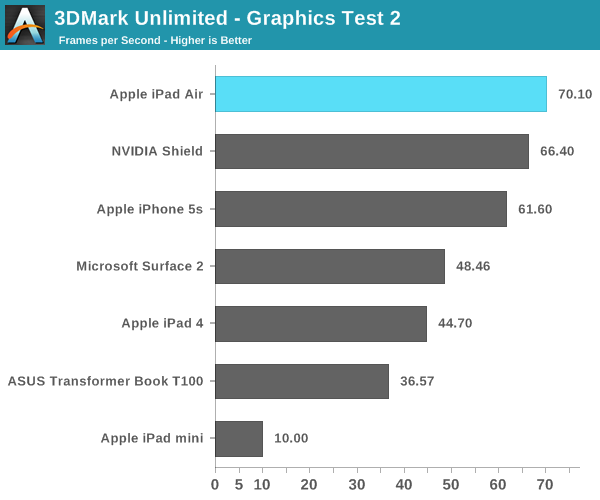
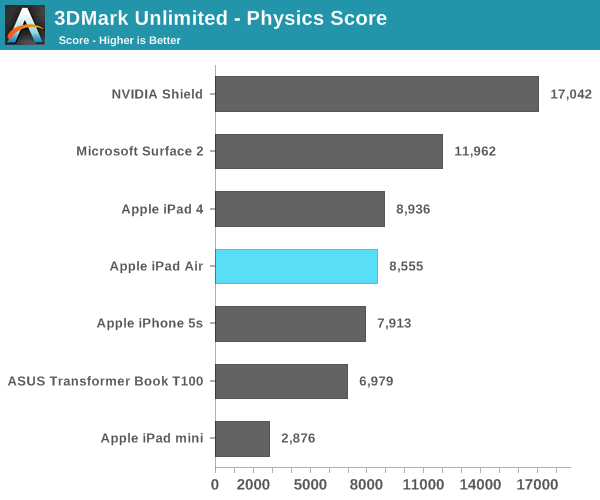
I'm still not entirely sure what's going on with the 3DMark Physics test, but we've seen this two reviews in a row now where Cyclone showed no performance increase at all compared to Swift despite this being largely a CPU test.
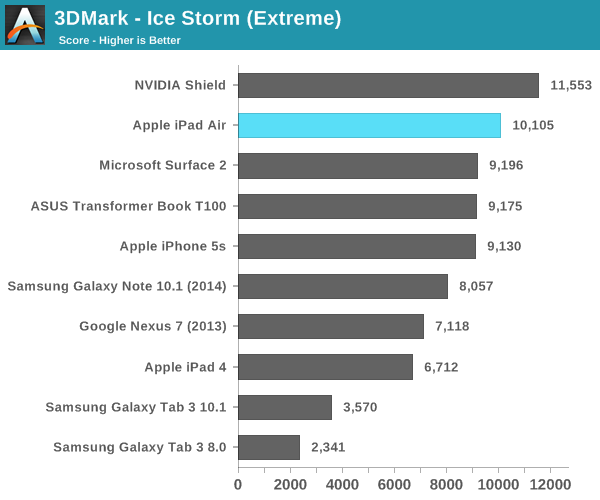
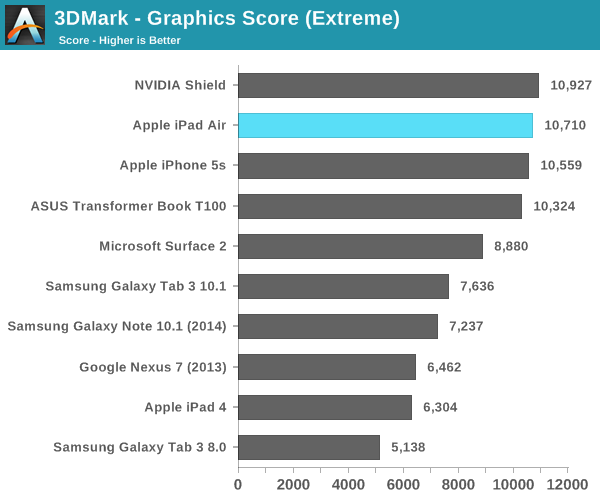
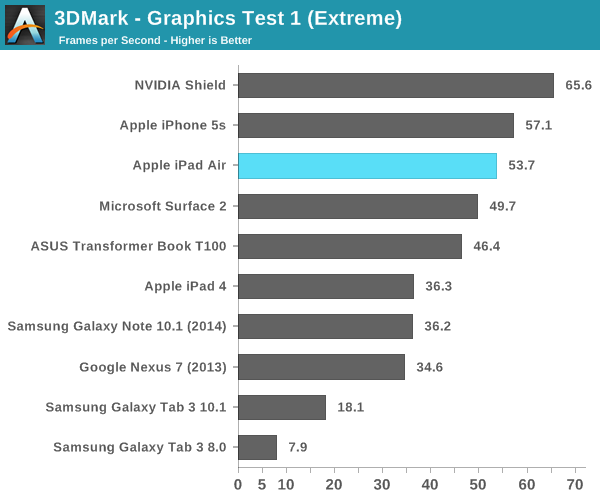
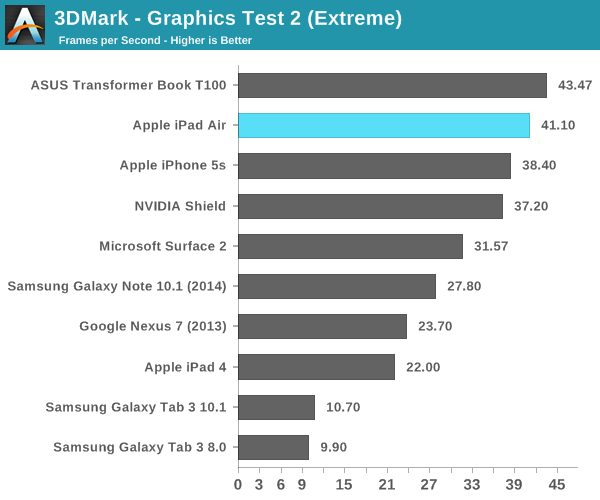

Basemark X
Basemark X is a new addition to our mobile GPU benchmark suite. There are no low level tests here, just some game simulation tests run at both onscreen (device resolution) and offscreen (1080p, no vsync) settings. The scene complexity is far closer to GLBenchmark 2.7 than the new 3DMark Ice Storm benchmark, so frame rates are pretty low.
I'm still having random issues with Basemark X reliably running both on and offscreen tests on iOS 7. Unfortunately I could only get onscreen results for the iPad Air, which came in at 46% faster than the iPad 4. Note the iPad mini and iPhone 5s benefit from having lower native resolutions here, which is why they perform so well.
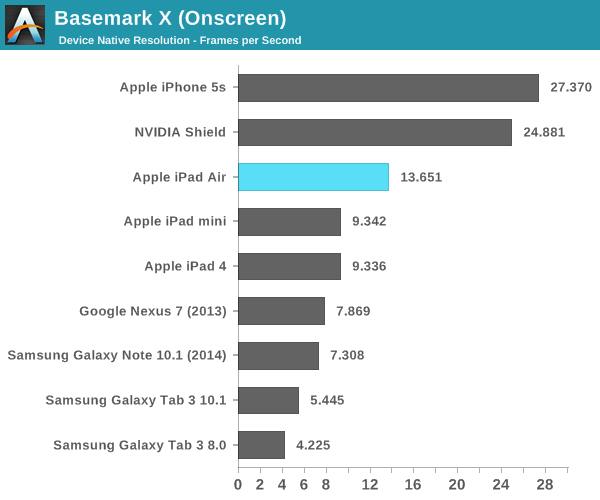










444 Comments
View All Comments
blacks329 - Tuesday, October 29, 2013 - link
The pointless dilemma caused by AnandTech reviews: Do I read it now and spoil all my other reviews, or do I save it for later after reading all the other 'reviews' but feel underwhelmed by reading them.I feel like a child wanting to have dessert, except this dessert is actually better for me than the main course, but I'm gonna have the main course anyway because of my OCD with tech reviews.
(I like reading multiple reviews for a product - even if I have no intent to purchase them)
ArthurG - Tuesday, October 29, 2013 - link
a bit OT, but more I look at the graphs, more I think SHIELD is a great piece of hardware ! Screen, GPU performance and battery life are top class. And with the last 4.3 update, its coming all together on the software side.I'm holding the trigger because I think SHIELD 2 will be the real deal with amazing Logan GPU. But the first iteration is already very tempting...
Commodus - Tuesday, October 29, 2013 - link
Definitely. There's a certain cruel irony to it leading in some tests, because many will skip over it as a matter of course -- it's not a tablet, after all.Arbee - Wednesday, October 30, 2013 - link
I have a Shield (I can't help it, I'm an early adopter) and I think it's an underrated device (although AT's Brian Klug has been pretty positive on it). Weight is a bit excessive, but it's hard to beat for mobile gaming - the controls are better than either the 3DS or Vita, even if the game selection is kind of anemic. For now I don't care though, I have GTA 3 and Vice City with real controls in my carry-on bag. That would've been science fiction 10 years ago.Khato - Tuesday, October 29, 2013 - link
Simply awesome to see the greater depth of detail regarding the A7. Many thanks for doing so as most don't seem interested in understanding why it's performing so well. Given the magnitude of the geekbench subscore performance improvements I was convinced that somehow the frequency being reported was incorrect, but instead they made it a surprisingly 'wide' core. (As in, after accounting for the difference in ISA, it may well be comparable to Intel's core line in that respect.)Of course this really brings into question how a Baytrail-T (or even Haswell-Y) based tablet compares to the iPad Air in the platform power consumption metric. (Same goes for Snapdragon 800 and Tegra 4 just because it's a useful data point to have when looking forward to these SoCs being used for applications that actually need compute power.) Given that the idle -> load delta for A7 looks to be ~3W for Kraken and ~7W for the maximum...
Which reminds me, are the power numbers you listed for T-Rex offscreen and Infinity Blade 3 total platform power consumption or the delta? Curious since if it's total that would mean that gaming uses less power than Kraken?
MrRez - Tuesday, October 29, 2013 - link
The Shield is a beast :)ltcommanderdata - Tuesday, October 29, 2013 - link
The A7 die shot is labeled with 4 DRAM interfaces. 2 large ones (presumably the main 2x32-bit memory bus) and 2 smaller ones (maybe 16-bit wide each). Any idea what the smaller ones are used for?errorr - Wednesday, October 30, 2013 - link
I would assume they are for all the other peripheral devices or what we used to call a northbridgeMykeM - Tuesday, October 29, 2013 - link
The battery time looks awfully nice. Of course, the iPad 4 is no slouch although as I'm holding it, it also makes complete sense that something so heavy should hold a battery that lasts as long.iPad Mini is never an option for me. Try running apps like Korg iMS-20 on the Mini: it's a nightmare filled with minuscule knobs and sliders. So a 1 lbs full sized iPad with better battery life and more powerful sounds mighty tempting. I'm hoping Apple would even go bigger- 12, 13 or even 15" iPad (Pro).
Arbee - Wednesday, October 30, 2013 - link
Agreed. A 13" iPad Pro would be awesome for iMS-20, among other things.Related to this, I wish Anand would get in touch with how people actually use iPads (e.g. the whole AudioBus and music creation scene). He seems stuck in the "but doing office stuff on it isn't as good as a PC" rut because that's all he uses PCs for, and it's lead him to not understand why the iPad is dominant while Android and Windows tablets struggle.